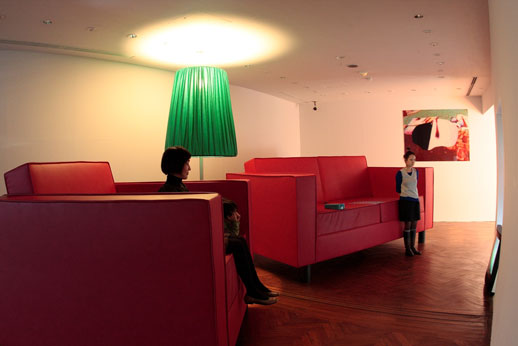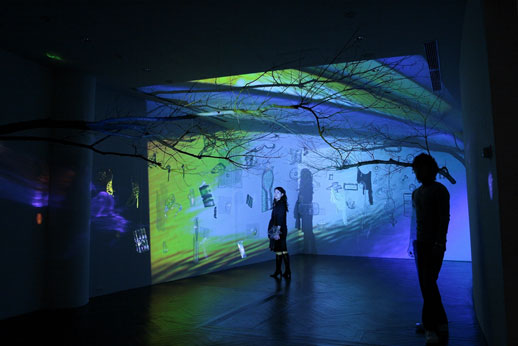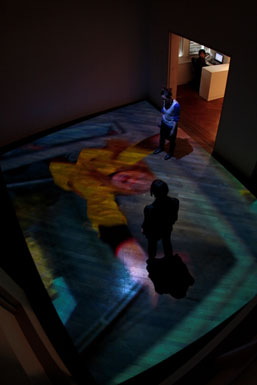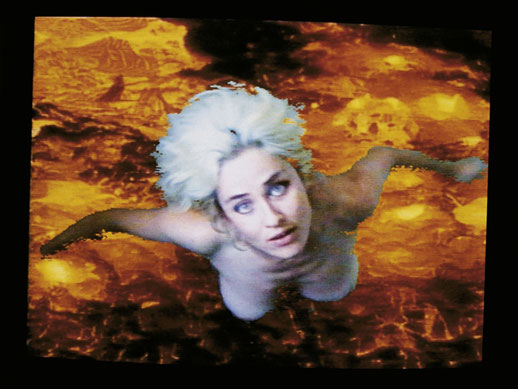Deeper than the Water
Hailing from Switzerland, Ms. Pipilotti Rist has become one of the art world’s foremost voices and visionaries working in video, sound and installation art. Her works strike a delicate balance between the physical and the psychological, the rational and the intuitive. Rist, who has been working since the mid-1980s, creates works that often montage incongruous scales and spaces to create colorfully vivid, yet dreamy, spaces that heighten the viewer’s awareness of space, time, corporeality, gender, instinct, and social conventions.
No stranger to Japan, Ms. Rist has shown here extensively. In 1999 she exhibited in Dream of the Body at The National Museum of Modern Art, Kyoto and at Museum of Contemporary Art, Tokyo. She participated in the Yokohama Triennale 2001 and held a solo exhibition at the Shiseido Gallery in 2002. However, it is the Hara Museum of Contemporary Art that is currently presenting her first solo exhibit at a Japanese museum. The museum is a perfect setting for Rist’s works, which often address domestic themes and spaces.
The day before her opening I had the chance to sit down with the affable Pipilotti Rist and discuss her work and the exhibition. As I walked into the museum’s sunroom, she jumped up from lying on the floor where she had been battling jet lag. Her tiredness did nothing to hold back her thoughts. It may have even fueled some of the associative leaps that ran throughout our conversation. After a preparing her coffee Rist quickly broke the ice and we launched into an hour-long conversation…
——-
Pipilotti: I don’t mind, or even would prefer, if you would make a text of your own ideas or interpretations, because I’m not sure I am awake enough to give some substantial…content.
You have had several solo exhibits, but this is your first museum-scale solo exhibit in Japan. Although you’ve worked here several times before, how does it feel?
Yeah four times now. This is the first time for a whole solo show. But I’ve been in contact with the Hara people for more than four years. And I especially like the concept of this museum, that Mr. Hara settled into the house next door and made his parents’ house into a museum.

Did that have any influence on which works were selected and their relation to the garden and this type of space – a more domestic space?
Some of the works are so connected with domestic space that we decided we would like to show them, but that was also blurred with the concept of having a retrospective so that people can see older works too. So it was a mix between these two concepts. I once made a show where the whole idea was having a bathroom, a living room, a sleeping room, etc. [Closet Circuit, 2000; Das Zimmer (The Room, 1994/2007) and Deine Raumkapsel (Your Space-Capsule, 2006), respectively, are included in the exhibition.] But here it is not so conceptually linked with the former use of the house. But I like it a lot. I have a personal “system for ranking curators and museums” and the people at Hara come quite high up on it. They are very serious, hands-on, committed and honest.
Towards the end of the catalog Congratulations! you mention your studio, showing that your work comes from a larger body of people who are doing many things. It seems like this is a larger expansion of that.
The people I work with in the institution where I am showing also have an influence. Often they are ignored or not mentioned. In film it’s normal to credit everybody, but in art there is so much focus on the idea of a genius that we have lost the idea of it being a group effort. My ranking is more of a joke because curators always do artist rankings and they all have lists with different criteria. But I did not publish mine. [Laughs]
You talk about music or the soundtrack being very important to the work. You plan for it at the beginning but it seems that Anders Guggisberg [long-time audio collaborator] is doing a lot of that work. How do you work with him to coordinate visual-spatial concepts with the acoustic?
Often the footage comes first and the soundtrack comes later, but in every work it’s a bit different. Also, he was the music chief in the feature film I was shooting this summer. But it’s not totally correct that I give it over and he is doing the music. Most of the sounds are collaborations. He handles the timetable.
You write the score together and he engineers it?
Yeah, he’s more the chief of the audio machines, and with the video machine I’m more the chief.
Do you still maintain a dialog from beginning to end?
Yes, very much so. Also, I play some of the instruments. He is with another artist as a kind of artist couple. He does cabaret for half of the year so he is free to collaborate with me for the other half. But we share the same studio, and the sound studio is one floor up where we have a self-made capsule to take in the acoustic instruments, voices. But over the last twenty years, machines have become much smaller and more affordable. Now we work a lot at home also. Before we were really stuck to the big machines and we had to share them with a group. Now we’re much more flexible and, as you said, we can do the final mixing in the room itself, like in the church in Venice. That makes a big difference. Also, for the video, all the final color corrections be can done on the spot whereas before you had to run home, change it, go back and fiddle around.
So it has become more portable and…
Ladylike.
Ladylike!? Can you explain that?
Yeah. Ladylike is a good expression. When I started, the recorders and the cameras were so heavy…and we are, at least physically, weaker [laughs]. You know, it made a big difference.
![Courtesy of the artist and Hauser & Wirth Zürich London Pipilotti Rist, from the video installation 'Open My Glade (Flatten)' (2000) [not on show in this exhibition]](http://www.tokyoartbeat.com/tablog/entries.en/wp-content/uploads/2007/11/pipilottiristportrait.jpg)
Many people have labeled you a feminist artist, which you accept partially, but not as hardcore/intellectual feminism. Is your idea of feminism based more on basic human civility and equality in relations, and is exploring bodies and space where your work is heading? Some of the more recent work is less overtly about the female body. I just saw Gina’s Mobile (2007) and it looks like endoscopy, looking at the body from the interior. And that raises another issue: scale. It’s so close. Is it eliminating the identity of the body and viewing the body as cells and physical tissue, while alluding to identity or femininity with the title?
Yeah, in this case it’s really fragmented. That is one of the healing possibilities of that work. That we are so fragile that certain parts of our bodies make us completely vulnerable in the case of our identities and hearts. If somebody touches this part of our body [touches her shoulder] it brings us to existential questions. Is it only a cultural and social thing or how much of it is instinctive? And with this work I would like to jump away so that we can have a possibility at least to look at our bodies, or to feel our bodies, as much as possible free from taboos. Of course, I agree with some taboos to also protect ourselves, but in the end it brings so many problems: that we want to be slick and we are not able to accept our chaos, per se.
But the other question of feminism, you asked what changed? With age I became ambivalent to all ideologies. And for me there are always four kinds of people: the good people with the bad ideology, the bad with the good ideology, the good with the good ideology, and the bad with the bad ideology. So that’s why I cannot judge somebody by theoretical thoughts. I even know from myself that if I call myself feminist, which I think is a case of honor or just ‘normal’, you know…my prejudice or my behavior is not there where I theoretically would like to be. We need some more generations to pass because it’s rooted very deep down. For example if we speak of the person who did the camerawork, I also picture a man in my mind, and never a woman, for example. Just all these deep-rooted ideas.
Does that tie in with your idea of linguistic terms—that so much is deep rooted to separate ideas of gender and gender roles?
Yeah, it’s very deeply rooted. We often have the tendency when we see a female body to think it stands only for women. On the contrary if we see the Leonardo DaVinci man, the one [stands up with legs and arm outstretched], then we think it’s a symbol for human beings as a whole, not only for men, you know. For me the female body is normal and the male body is the exception. So if I treat the female body it’s not only about women, it’s also about…you. But our perception is still there, it’s excluding, including. So if I show a symbol of a human figure it’s first a human figure and only second the gender. That also gives me some say in on how much femininity, because I specialize on women. But I’m like a zoologist who specializes in zebras and not in dolphins, but that doesn’t mean I don’t like dolphins.
I’m sure if the movement horizon of the female is widened in the same moment it also widens male possibilities. We have such different characters. There are many men who are so much more female than some women. Age doesn’t make it easier for all the ambivalence that comes out of it, seeing that no one really has the truth. And also there’s the realization that every ‘macho’ man had a woman, had a mother, to bring him to where he is. I would not blame anyone because the mother was a construct of her mother and father and so on.
At the moment it’s changing a lot. But I am also questioning when we lose so many stereotypes. How do we find new rituals? I’m sure we need rituals. The whole male-female thing is very much linked with you knowing how to move, how to behave, what to do in which situation. See, here is exactly the problem: just because we don’t want to keep certain customs shouldn’t mean that we avoid the interesting parts. How can we find a new place? It’s a really big question.
Always in evolution or flux. This brings me back to video. At one time you were using water as a major theme, do those ideas all intertwine as systems evolving and ideas in flux?
You know it’s a great symbol of depth.
Are water and video a metaphor for each other—the way you use the video in larger sized installations to occupy the entire room, mixing projection with space where the body enters it and the images wash over the viewer?
Exactly, washing up the viewers’ legs. But we use water in many more, different ways. As with video and electronics we are extremely stuck to the flat, vertical format. This format has extremely practical reasons. Even in architecture they always say this is the most beautiful thing. But to be honest, half of it is a practical need. We cannot afford to build like this [gestures wildly], from gravity, aesthetics, etc. Then you call it aesthetic invention. I would be very much interested to see in a hundred years how we deal with visualized information. Is it still on these screens? How can we really swim in it? My propositions are low-cost low-tech propositions of different uses of electronic representation.

And, in your case, presentation, the way you show what you’re showing: on the walls, on the floor, in the floor, projected onto other items.
Of course the content is representing, but the situation that the body is coming in to the installation at a moment I don’t know and going out when she wants. And I’m also interested in that you can fall back and maybe you see the grid. I do not try to hide the specific quality, or even shortcomings. But, for me, it has a more contemplative dimension, a real texture. It’s a bit symbolic with the trash and the plastic. [Referring to Apple Tree Innocent On Diamond Hill (2003)] We have that with us everyday, but of course we would go crazy if we watched every reflection. But too much, I don’t want to sound too ‘rar rar rar’ like I’m preaching. No, my intentions are that it’s a mix between representation and the moment where you see it. I’m not ignoring the media, but it should be in a balance…with music.
Does that all come back together with the installation space: the creation of a psychological space that in turn creates a space that we can enter that, as you said, when we touch one part of the body other parts and thoughts are stimulated?
Yeah, absolutely. If houses are a doubling of our skin and we are isolated in our skin and the house is the next protection in the condition of physical nature, then culture or painting, videos and projection are a parallel of the layers in the brain of our inner world. What is here, and then here, and in between – this links with different layers of our defenses. So when we sit here maybe we remember a sound from yesterday and you may already be thinking of what you have to do in the afternoon.
I think artists are not wilder than anybody, but we just take the time to concentrate on the layers between skin and art.

I’m curious about your ideas of space, because you’re dealing with many different forms, scales of space along with video and sound and the viewers’ relations to those. For example, in À la belle étoile (Under the Sky, 2007) in the first room, the video is projected on the floor of the entire room where people can move into it. Then next we have Selbstlos im Lavabad (Selfless in a Bath of Lava, 1994) where it’s coming up through the floor. What are your ideas when you devise these spatial relations to the viewer?
You bow. It’s already a gesture of helping. Or, like when you go to church, you go in through a small door. [Referencing Homo Sapiens Sapiens (2005) her contribution to the 2005 Venice Biennale, which was installed in the San Stae Church.]
How are you conceiving them in terms of scale—the relation of the projections to the work itself to the larger space? Because I see that you’re very conscious about the space within the works.
Yes, I try to be. Size is very relative. It’s a question of concentration. When you’re touched as we said before, this [points to a pen] can become one kilometer long and if you’re in another state of mind it shrinks. So how big our body is is completely irrelevant in relation to space, our space, and imagination, or the macro/micro.
Here we are in a human scaled space. But this also always links to constraints: what you can afford to build and what I can afford to bring. For example, we wanted to bring a different thing there, carpets. This was from this spring. [In the catalog Congratulations! Pipilotti points to Tyngdkraft, var min vän (Gravity, Be My Friend, 2007).] I wanted to bring this into the first room but I couldn’t afford to transport it. So it’s not only about free artistic vision. Even with great sponsorship I had to think what else would fit to that room. I liked the double possibility of looking from upwards to downwards and what it meant before—Why was this room double height in the first place?
And I’m interested in how much more Japanese culture is about living on the floor, but the floor as a media is in a way ignored—not ignored, that always sounds so moralistic—not considered much. Because our eyes are built here [she stands] we always put everything in this vertical space, and electronic media especially, or even analog media, is already reduced to that. It could have been that evolution had morphed our eyes here [gestures to her cheeks]. Or maybe if we would for some generations project on the floor then our eyes would come down here [gestures to her chin]. I don’t know if I touched anywhere on your question.
I think of it more as conversation than specific questions.
Good, even better. And for me anyway what’s more impressing—the biggest part of the text—is your own reaction or reflection.

One thing that I was curious about in your new work Gina’s Mobile, is whether there is any wordplay? When I heard the title I thought of “genus” from the scientific ordering.
No, but thank you very much. Arigato gozaimasu. That’s really good. I didn’t make that connection.
I could see the body and the body in balance.
Yes, of course there’s a body in balance and virtuality. If you watch it from outside sometimes it can be so crazy how there are certain skin parts that are so much more important than other skin parts. But that’s good, genus. But the title is more superficial. The photographer who took the photos is called Gina, Gina Folie, which is also a good name; folie, it means ‘crazy’ in French. But with genus, you have an animal.
You have used Homo Sapiens Sapiens as a title before.
It interests me a lot to think about the human as an animal. We are trying hard to reconcile instinct and rationale. But we lost a lot of instinct. So many animals have huge forces. They hear and smell and they do the right thing at the right moment. And we have the ability to reflect, but we had to pay for it by losing a lot of great instincts.
Does that go back to your credo: “An ounce of innocence lost must be made up with a pound of know how”?
Yes, that’s particularly in the profession also. If you lose the instinctive, completely intuitive way towards work you have to make it up. It’s the same in writing. I think it’s in all different spaces. I guess you remember that you could roll through the text very instinctively, and then you say, “Oh, it’s not bad,” or someone understood me and I was not alone anymore in that moment. The next time if we use the same recipe it’s already not anymore as innocent as it was before. You have to make it up by knowing. For example, how to research, etc. I guess it’s quite similar whether you do video installation or play music.
How has it been working in Japan and what has been particularly productive or interesting for you? Is there anything that you may be taking with you as a cultural souvenir?
Yeah, I hope so, more in my private life than in my work. Before, I had a very personal relationship with machines, which I feel here too, maybe only more secure or Bestätigung [validated / reassured]. There are all the fanatic attitudes toward details, and I like fanatic people: the collectors and specialists, for example in very abstract music. I appreciate that a lot. I guess you also realize it as an American, that Japan is so much more into details and craft. They prefer to go into handicraft detail, and I appreciate that. Even people not working in the cultural field seem to know how to make a flower arrangement or understand aesthetics in a non-symmetrical manner, unlike the symmetrical orientation of western culture, which is my prejudice. Someone not trained in aesthetics would make something symmetrical to make it look good, but in Japan they would put something in here, and in here…estimated. And they accept the vanishing of materials – wood that really gets old is not treated as something ‘blech’ to quickly renew but that has its own aesthetic. I’m very fond of the woodwork here, and ceramics, and gardening. There’s a very tender attitude.
James Way
James Way



